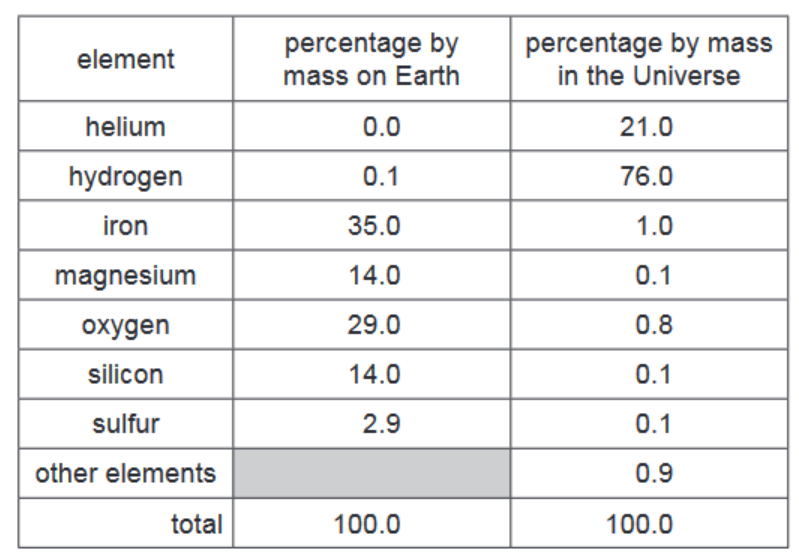Question
This question is about copper and copper compounds.
(a) Describe how you could prepare a pure sample of crystals of hydrated copper(II) sulfate using dilute sulfuric acid and an excess of copper(II) oxide.[3]
(b) Anhydrous copper(II) sulfate is used to test for water.
(b) Anhydrous copper(II) sulfate is used to test for water.
$
\begin{aligned}
& \mathrm{CuSO}_4+5 \mathrm{H}_2 \mathrm{O} \rightleftharpoons \mathrm{CuSO}_4 \cdot 5 \mathrm{H}_2 \mathrm{O} \\
& \text { anhydrous hydrated } \\
& \text { copper(II) sulfate copper(II) sulfate } \\
&
\end{aligned}
$
(i) What is meant by the symbol $\rightleftharpoons$ ?[1]
(ii) How can hydrated copper(II) sulfate be changed into anhydrous copper(II) sulfate?[1]
(c) Complete the table to calculate the relative formula mass of anhydrous copper(II) sulfate, $\mathrm{CuSO}_4$. Use your Periodic Table to help you.

relative formula mass = …………………………. [2]
(d) Complete the table to show the number of electrons, protons and neutrons in the sulfur atom and copper ion shown.

(e) Alloys of copper are used to make coins.
(i) What is meant by the term alloy?[1]
(ii) Suggest why an alloy of copper is used to make coins instead of using pure copper.[1] [Total: 13]
▶️Answer/Explanation
Ans:
a) any three from:
• heat copper oxide with sulfuric acid
• filter off (excess) copper oxide
• heat filtrate to point of crystallisation / heat (copper sulfate) solution to point of crystallisation
• dry between filter papers / dry in drying oven
(b)(i) reversible reaction 1
(b)(ii) heat / warm 1
(c) 160 (2 marks)
if 2 marks not scored 1 mark for S = (1 × 32) = 32 OR O (= 4 × 16) = 64
(d) electrons in S = 16 (1)
electrons in Cu 2+ = 27 (1)
neutrons in S = 18 AND neutrons in Cu 2+ = 34 (1)
protons in S = 16 (1)
(e)(i) mixture of metal and other elements 1
(e)(ii) (alloy) more resistant to wear / stronger / harder / more resistant to corrosion ORA for copper
Question
(a) The table shows the percentage by mass of the elements on Earth and in the Universe.

Answer these questions using only the information in the table.
(i) Deduce the percentage by mass of other elements present on Earth.$\%[1]$
(ii) Which non-metallic element is present on Earth in the greatest percentage by mass?[1]
(iii) Give two major differences in the percentage by mass of the elements on Earth and in the Universe.[2]
1
5
(b) Complete the diagram to show the electron arrangement in an oxygen atom.

(c) Helium, neon and argon are noble gases.
(i) Explain, in terms of the electronic structure, why neon is unreactive.[1]
(ii) State one use of argon.[1] [Total: 7]
▶️Answer/Explanation
Ans:
(a)(i) 5.0%
3(a)(ii) oxygen
3(a)(iii) any two from:
• more hydrogen in Universe (or reverse argument)
• more helium in Universe (or reverse argument)
• more oxygen on Earth (or reverse argument)
• more magnesium on Earth (or reverse argument)
• more iron on Earth (or reverse argument)
• more silicon on Earth (or reverse argument)
• more sulfur on Earth (or reverse argument)
(b) 2 electrons in inner shell AND 6 electrons in outer shell AND no additional shells of electrons
(c)(i) has complete outer (electron) shell / has full outer (electron) shell / outer shell cannot gain or lose electron(s)
(c)(ii) lamps / inert atmosphere (in metal extraction)
Question
This question is about iron and iron compounds.
(a) Name the main ore of iron. [1]
(b) In a blast furnace used for the extraction of iron, carbon reacts with oxygen from the air to form carbon monoxide.
Complete the chemical equation for this reaction.
$$
….. \rm{C}+\ldots \rightarrow2 \mathrm{CO}
$$ [2]
(c) In the hotter parts of the furnace, carbon reacts with the iron(III) oxide present in the iron ore.
$$
3 \mathrm{C}+\mathrm{Fe}_2 \mathrm{O}_3 \rightarrow 3 \mathrm{CO}+2 \mathrm{Fe}
$$
How does this equation show that carbon is oxidised? [1]
(d) Limestone is added to the blast furnace. The limestone is converted into calcium oxide and carbon dioxide. The reaction is endothermic.
$$
\mathrm{CaCO}_3 \stackrel{\text { heat }}{\longrightarrow} \mathrm{CaO}+\mathrm{CO}_2
$$
(i) What type of chemical reaction is this? [1]
(ii) What type of oxide is calcium oxide?
Give a reason for your answer. [2]
(e) Iron is a metal.
Give three physical properties that are characteristic of metals.
1……………………………………………
2…………………………………………
3 ……………………………………… [3]
(f) The structure of a compound of iron is shown.

Deduce the molecular formula of this compound to show the number of iron, carbon and oxygen atoms. [1]
▶️Answer/Explanation
Ans:
(a) hematite
(b) 2 (C) (1)
O2 (1)
(c) carbon gains oxygen (from Fe 2O3) / oxygen (from Fe 2O3) combines with carbon
(d)(i) thermal decomposition 1
(d)(ii) basic oxide (1)
calcium is a metal (oxide) (1)
(e) any three from:
• conduct electricity
• conduct heat
• malleable
• ductile
• shiny / lustrous
(f) $Fe_{2}C_{9}O_{9}$